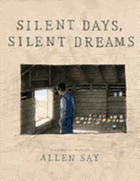
Boise, Idaho, is home to the James Castle Collection and Archive, commemorating an internationally renowned local artist who lived most of his 78 years in isolation. The sleek building stands in sharp contrast to the artist's actual lifetime studios: an attic, an abandoned chicken shed and a two-room trailer. "Deaf, mute, autistic and probably dyslexic," James survived childhood trauma and elevated his silent life by teaching himself to create stupendous art from salvaged materials.
Despite being one of seven children, James was mostly alone. His first, brief attempt at schooling left him forever "afraid of strangers." His father locked him in the attic to counter his only means of communication--"piercing screams of frustration." Using trash paper found around his family's farm, he used burnt matchsticks to draw. He survived five years at the Idaho School for the Deaf and the Blind, but was deemed "ineducable" at 15; the principal sent James home with warnings to deny him all drawing materials. James prevailed, stealing chimney soot, mixing it with his spit to draw, again on trash paper. His persistence never waned: "James drew everything he saw." Decades later, his nephew, Bob--"the only one he ever allowed in his studio"--would become James's messenger to the outside world.
Caldecott Medalist Allen Say's empathy moves beyond words, as he "emulat[es James's] unschooled style" by using similar methods, including soot and spit, and mimicking James's "unsteady lines" by switching from his dominant right hand to his left. Say's illuminating author's note provides indelible testimony to the metamorphic power of art as he transforms James's Silent Days, Silent Dreams into resonating homage and spectacular storytelling. --Terry Hong, Smithsonian BookDragon

